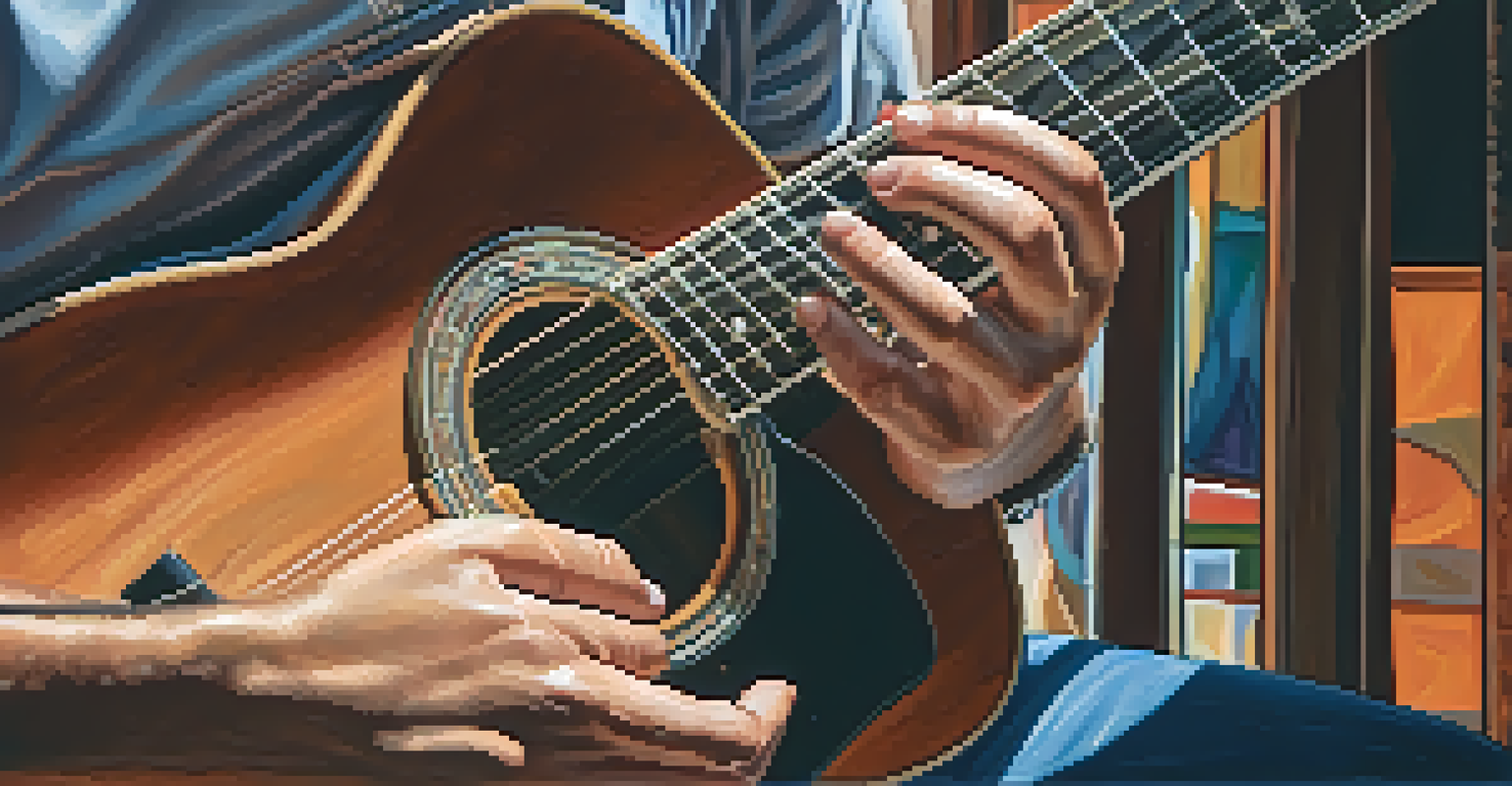Meditative Guitar Techniques for Beginners and Experts

Understanding the Connection Between Meditation and Music
Meditation and music share a profound connection that can deepen your practice. When you play the guitar mindfully, it becomes more than just a musical instrument; it transforms into a tool for expression and relaxation. This synergy allows you to tap into your emotions and clear your mind, making it easier to enter a meditative state.
Music can change the world because it can change people.
For beginners, this connection may feel abstract, but as you strum your guitar, focus on the sounds and sensations. Notice how each note resonates within you, helping to quiet your thoughts. Even for experienced players, revisiting this concept can reinvigorate your practice, enhancing both your musicality and mindfulness.
Ultimately, understanding this relationship can guide your practice towards a more fulfilling experience, whether you're just starting your guitar journey or you're a seasoned musician. Embrace this duality, and let it enhance your meditation sessions.
Basic Meditative Guitar Techniques for Beginners
Starting with simple techniques can set a solid foundation for your meditative guitar practice. One effective method is to focus on fingerpicking patterns, which can create a calming rhythm that helps center your mind. As you pick the strings, pay attention to the sound and the sensations in your fingers, allowing distractions to fade away.

Another beginner-friendly approach is to practice a single chord or a series of chords slowly. This allows you to immerse yourself in the sound and feel of each note. You can combine this with deep breathing exercises, inhaling as you strum and exhaling as you let the sound resonate, fostering a sense of tranquility.
Meditation Enhances Guitar Playing
Combining meditation with guitar practice fosters emotional expression and a deeper connection to music.
Lastly, don’t hesitate to explore open tunings, which can simplify finger placements and create beautiful, harmonious sounds. These techniques are not just about playing notes; they’re about developing a mindful relationship with your instrument.
Advanced Techniques for Experienced Guitar Players
For seasoned guitarists, meditative techniques can elevate your artistry. One such method is the practice of improvisation over a drone note, which allows for spontaneous creativity while maintaining a meditative focus. This technique encourages you to let go of control, embracing the moment and the music as it unfolds.
The mind is everything. What you think you become.
Another advanced technique involves using alternate picking and legato playing to create fluid, seamless melodies. By concentrating on the physicality of your playing, you can enhance your connection to the music and enter a deeper meditative state. This method not only enriches your sound but also fosters a sense of flow and ease in your playing.
Lastly, consider incorporating effects like reverb or delay, which can create an ethereal atmosphere, enhancing your meditative experience. These layers of sound can transport you and your listeners to a tranquil space, making your practice not just a routine but a journey of self-discovery.
Creating a Meditative Space for Your Practice
Setting the right environment is crucial for a successful meditative guitar practice. Choose a quiet, comfortable space where you can focus without interruptions. Soft lighting, comfortable seating, and minimal distractions can help set the mood, inviting a sense of peace and calm.
Another important aspect is to consider the time of day for your practice. Early mornings or late evenings tend to be quieter, allowing for a more introspective experience. By aligning your practice with these moments of stillness, you can enhance your connection to both the music and your surroundings.
Create a Peaceful Practice Space
Setting a quiet and comfortable environment is essential for enhancing your meditative guitar experience.
Lastly, think about incorporating elements such as incense, candles, or calming visuals to enrich your practice space. These sensory details can help create an atmosphere conducive to meditation, allowing your guitar playing to flow more naturally and effortlessly.
Using Breath Control to Enhance Your Playing
Breath control is a fundamental aspect of both meditation and playing the guitar. By synchronizing your breath with your strumming or picking, you can create a rhythmic flow that enhances both your focus and sound. Start by taking deep, slow breaths as you play, allowing your breathing to guide your movements.
As you progress, experiment with varying your breath patterns in relation to your playing. For instance, inhale during softer passages and exhale during more intense moments. This technique not only helps regulate your energy but also deepens your emotional connection to the music.
Ultimately, mastering breath control can transform your guitar practice into a more meditative experience. It encourages mindfulness, helping you stay present and engaged with each note, creating a harmonious balance between music and meditation.
Incorporating Nature Sounds into Your Guitar Practice
Nature sounds can significantly enhance your meditative guitar practice, creating a peaceful backdrop for your music. Whether it’s the sound of flowing water, rustling leaves, or gentle bird songs, these natural elements can help ground you and deepen your connection to your surroundings. Consider playing your guitar outside or using recordings of nature sounds to set the mood.
As you play along with these sounds, notice how they influence your rhythm and melody. For example, strumming softly to mimic the gentle rustle of leaves can create a serene atmosphere. This blending of nature and music can stimulate creativity and promote a deeper state of relaxation.
Incorporate Breath Control Techniques
Synchronizing breath with your playing can elevate focus and deepen the emotional connection to your music.
By incorporating nature into your practice, you not only cultivate a more immersive experience but also honor the interconnectedness of music and the environment. This approach encourages mindfulness and helps keep your practice fresh and exciting.
Establishing a Regular Meditative Practice Routine
Creating a consistent practice routine is essential for developing your meditative guitar skills. Begin by setting aside dedicated time each day, even if it’s just 10 to 15 minutes. Consistency is key, as it helps reinforce the connection between your guitar playing and meditation, making the process feel more natural.
As you establish your routine, be mindful of your intentions. Consider what you want to achieve during each session, whether it’s relaxation, creativity, or emotional expression. This clarity will help guide your practice and keep you focused on your goals.

Lastly, remember to be gentle with yourself throughout this journey. Progress may come slowly, but every moment spent practicing is a step towards enhancing your skills and deepening your meditative experience. Embrace the journey, and enjoy the process of growth.